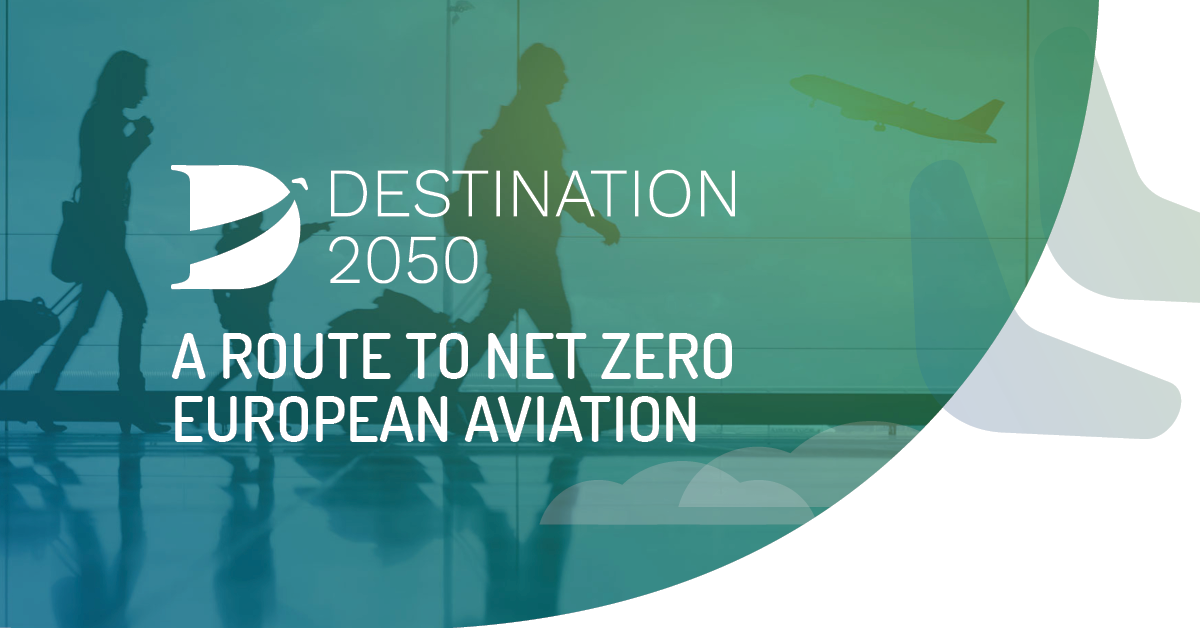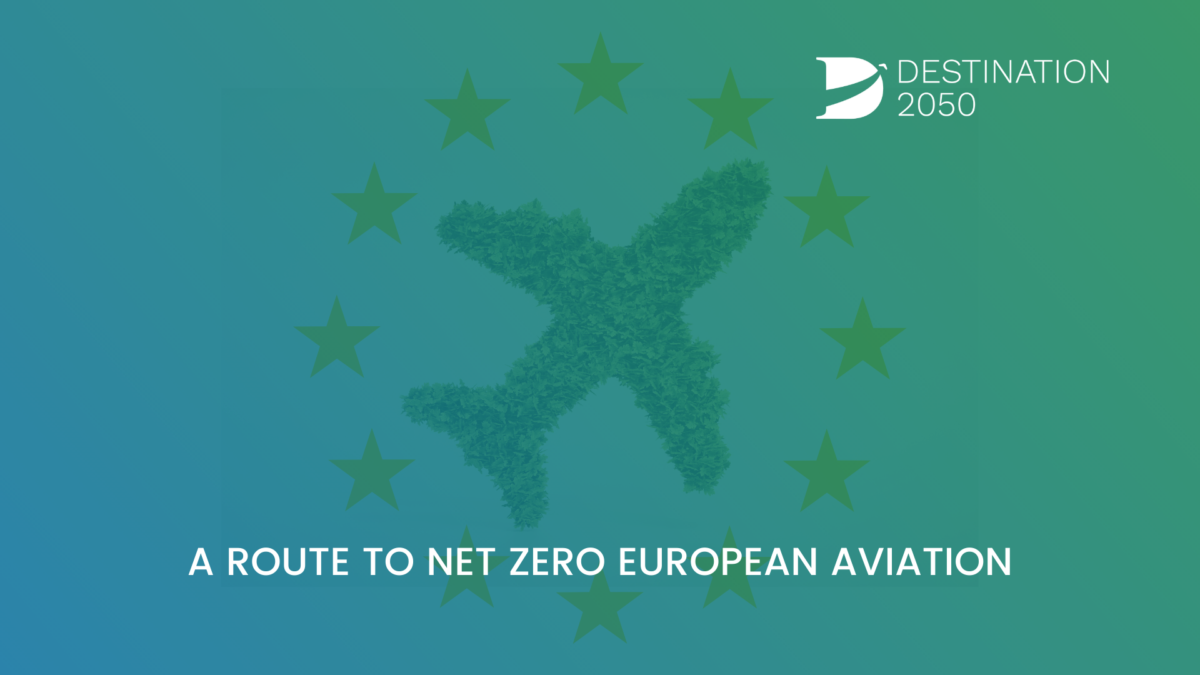- Destination 2050 already shows a pathway for Europe’s aviation sector to decarbonise, in line with the EU’s 2050 climate objectives.
- Pact would complement European Commission’s ‘Fit for 55’ policies to ensure aviation can meet its decarbonisation targets.
Brussels, 14 July 2021 — In its ‘Fit for 55’ legislative package published today, the European Commission set out proposals aimed at reducing net EU greenhouse gas (GHG) emissions by at least 55%1 by 2030. This represents a major stepping stone to reach the EU’s climate goal of net zero emissions by 2050 and is also aligned with the aviation sector’s own objective of achieving net zero CO2 emissions from all flights within and departing Europe by 2050.
To support the ‘Fit for 55’ initiative and ensure climate targets can be reached, Europe’s leading airlines, airports, air navigation service providers and manufacturers2 have proposed the development of an EU Pact for Sustainable Aviation — a joint roadmap for industry and policymakers to align their actions towards realising the 2030 and 2050 climate goals. The Pact – led by the European Commission – would set out a shared vision, common aspirational targets and high-level principles for joint aviation and policymaker action.The Destination 2050 initiative, launched earlier this year, shows how a combination of measures across four pillars can be used to achieve net zero CO2 emissions from aviation by 2050, namely:
- Improvements in aircraft and engine technologies;
- Ramp-up in production and uptake of sustainable aviation fuels (SAFs);
- Implementation of smart economic measures;
- Improvements in air traffic management (ATM) and aircraft operations.
“European aviation supports the Commission’s climate ambitions and Destination 2050 is our sector’s contribution to their implementation – but the roadmap clearly shows that we cannot do this alone. Realising our ambition and achieving a net zero European aviation requires fully aligned and enabling policy, regulatory and financial frameworks – both at EU and national level. For this reason we call on the European Commission to support and take the lead in the development of an EU Pact for Sustainable Aviation to drive these proposals forward. We stand ready to engage with the European Commission to define such a Pact and hold regular exchanges to ensure its implementation”, said the five Destination 2050 associations.
The associations have also outlined their proposal to make Europe the hub for net zero CO2 flight in an Editorial published yesterday3.
- 55% compared to 1990 levels.
- Airlines for Europe (A4E); Airports Council International Europe (ACI EUROPE); European Regions Airline Association (ERA); Civil Air Navigation Services Organisation (CANSO) and Aerospace and Defence Manufacturers Association (ASD).
- https://www.destination2050.eu/make-europe-the-hub-for-net-zero-co2-flight/
Note to editors
About ACI EUROPE (Airports Council International)
ACI EUROPE is the European region of Airports Council International (ACI), the only worldwide professional association of airport operators. ACI EUROPE represents over 500 airports in 55 countries. Our members facilitate over 90% of commercial air traffic in Europe. Air transport supports 13.5 million jobs, generating €886 billion in European economic activity (4.4% of GDP). In response to the Climate Emergency, in June 2019 our members committed to achieving Net Zero carbon emissions for operations under their control by 2050, without offsetting.
About ASD Europe
ASD is the voice of European Aeronautics, Space, Defence and Security Industries, actively promoting and supporting the competitive development of the sector by advocating common positions towards European Institutions and International organisations.
About Airlines for Europe (A4E)
Launched in 2016, Airlines for Europe (A4E) is Europe’s largest airline association, based in Brussels. The organisation advocates on behalf of its members to help shape EU aviation policy to the benefit of consumers, ensuring a continued safe and competitive air transport market. With more than 720 million passengers carried in 2019, A4E members account for more than 70 per cent of the continent’s journeys, operating more than 3,000 aircraft and generating more than EUR 130 billion in annual turnover. Members with air cargo and mail activities transport more than 5 million tons of goods each year to more than 360 destinations either by freighters or passenger aircraft. Current members include Aegean, airBaltic, Air France-KLM Group, Cargolux, easyJet, Finnair, Icelandair, International Airlines Group (IAG), Jet2.com, Lufthansa Group, Norwegian, Ryanair Holdings, Smartwings, TAP Air Portugal, TUI and Volotea. Follow us on Twitter @A4Europe.
About Civil Air Navigation Services Organisation (CANSO)
CANSO – the Civil Air Navigation Services Organisation – is the global voice of the air traffic management (ATM) industry and is shaping our future skies. Our members support over 90% of the world’s air traffic and include air navigation service providers, airspace users and operators, manufacturers and aviation industry suppliers. We raise the bar on global ATM performance by connecting the industry to share knowledge, expertise and innovation. For more, visit canso.org.
About European Regions Airline Association (ERA)
Founded in 1980, European Regions Airline Association (ERA) is a non-profit trade association representing over 60 airlines and around 150 companies involved in European air transport and is the only association representing the entire spectrum of companies involved in European aviation. The association promotes the interests of European airlines by lobbying European regulatory bodies on policy matters, promoting the social and economic importance of air transport and its environmental commitments.
Media Contacts
ACI Europe
Siobhán O’Donnell, Acting Director, Media & Communications
Email: siobhan.odonnell@daa.ie
Phone: +353 87 2710065
ASD
Adrian Schmitz, Communications Director
Email: adrian.schmitz@asd-europe.org
Phone: +32 473 13 33 30
A4E
Jennifer Janzen, Communications Director
Email: Jennifer.Janzen@a4e.eu
Phone: +32 499 82 82 94
CANSO
Johnny Pring, Manager Europe Policy and Advocacy
Email: johnny.pring@canso.org
Phone: +32 493 53 61 24
ERA
Paula Bangle, General Manager Business Development & Communications
Email: paula.bangle@eraa.org
Phone: +44 1276 485558


